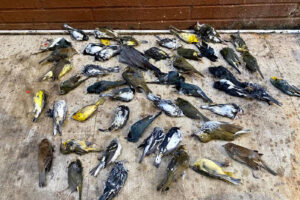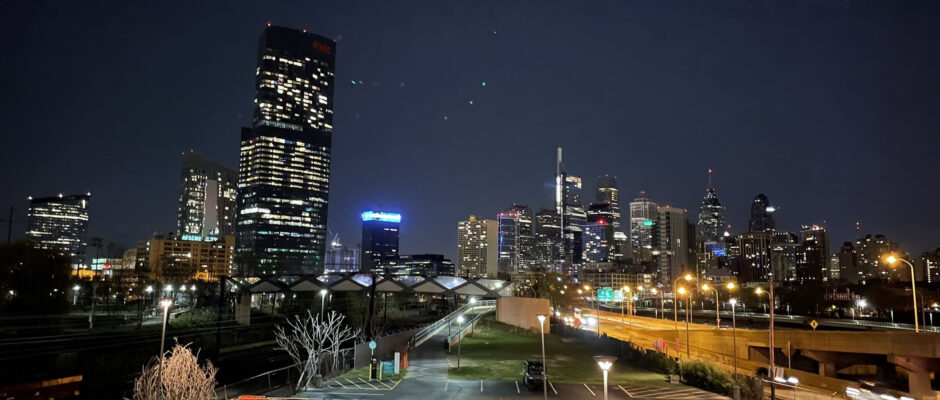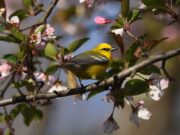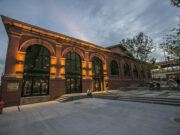This story originally ran in September 2021.
Philadelphia’s airport isn’t even in the country’s top ten in terms of its size, but try telling that to the birds. Located right in the middle of a key East Coast migratory route known as the Atlantic Flyway, Philly’s airspace is critical to masses of migrating birds. Now Lights Out Philly, an initiative launched last March by Bird Safe Philly in partnership with the city and the local building industry, is making that annual journey safer for our feathered friends.
Radar studies consistently indicate that up to 100 million migrating birds fly over the City of Philadelphia each year. Bird Safe Philly estimates that up to one billion birds die every year in U.S. cities when they strike buildings and windows — and many of these losses happen when birds become disoriented by nighttime lights on skyscrapers, city apartments, stadiums, and floodlit monuments.
“Birds do incredible things,” says Keith Russell, program manager for urban conservation at Audubon Mid-Atlantic, a leading Lights Out Philly partner alongside the Academy of Natural Sciences of Drexel University and the Delaware Valley Ornithological Club. Migrating birds navigate in a variety of ways, including sensing the polarity of the Earth and following landmarks on the ground as well as patterns of the stars. Many bird species must travel huge distances seasonally to breed, nest, and find food.
It establishes that sense of camaraderie among residents who dim their lights voluntarily. There were no complaints.Kristine Kiphorn, BOMA
“They have these maps that they’re born with,” he explains. “These birds are using the stars to find a way, migrating at night,” when predators can’t see them. But nighttime is also when birds are vulnerable to city lights, particularly in cloudy or rainy weather.
Imagine being in a dark room. If you suddenly saw a light, you’d naturally move toward it, and birds do the same when visibility is poor. But their eyes can’t adjust in time for them to avoid hitting buildings, many of which have reflective windows that the birds can’t perceive as glass.

“Lights can cause mass mortality at night, especially if there’s weather that impairs navigation by stars,” says Russell. On October 2, 2020, an unusually large number of birds struck Philly buildings, probably because of the cloudy weather. The feathered bodies in the street garnered far-reaching press, and helped galvanize Lights Out Philly the following spring,
“You look at these little jewels dead on the ground and it’s so sad,” he says of the tiny, colorful warblers who often die as they pass over Philly on their way to seasonal Pennsylvania habitats.
Kristine Kiphorn agrees. As the executive of Philadelphia’s Building Owners & Managers Association (BOMA), she was excited to join Lights Out Philly.
“Who wants to see these poor dead birds all over the streets?” she says.
The Bird Safe Philly coalition approached BOMA about Lights Out Philly in early 2021, and the program came together quickly.
The inaugural season of Lights Out Philly launched on April 1 and ran through May 31, covering the peak spring migration. The fall season runs August 15 through November 15. On those dates, participating property managers and tenants voluntarily switch off unnecessary lights between midnight and 6 a.m., and turn off or dim external lighting. Philly is joining 33 other cities that have their own Lights Out programs, including neighbors like New York, Wilmington, and Washington, D.C. Pittsburgh just signed on this month.


Signing on made economic, ecological, and ethical sense, says Kiphorn: Dimming the lights saves money on energy, plus it feels good to be part of a conservation solution and to be kind to the birds. BOMA, the Building Industry Association of Philadelphia, and the city’s Office of Sustainability quickly endorsed Lights Out Philly. Other participants include Comcast, Brandywine Realty Trust (the city’s largest landlord), One and Two Liberty Place, the Mellon Bank Center, and the Wells Fargo Center.
“It establishes that sense of camaraderie among residents who dim their lights voluntarily,” says Kiphorn. “There were no complaints.”
“The companies, organizations, and businesses see this as an opportunity to make a difference,” adds Russell, noting that Bird Safe Philly will continue to promote the cost-saving aspect as well, presenting studies from other cities on energy savings.
It’s too early to know how many birds are being saved in Philly, but the coalition will be watching as the program continues. Let’s hope for friendly skies.
ALAINA JOHNS is a Philadelphia-based freelance writer and the Editor-in-Chief of BroadStreetReview.com, Philly’s hub for arts, culture and commentary.



